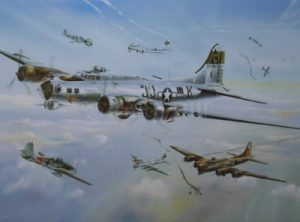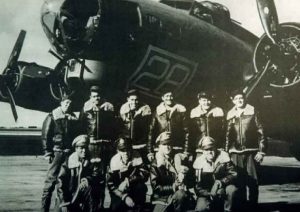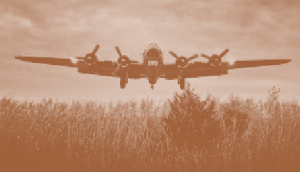26 Jul 2024
By around noon on that Tuesday in February, 1944, the USAAF 305th Bomb Group were over the coast of Denmark. The sky was blotted with the deadly black smoke-puffs of flak from 88mm anti-aircraft guns. Worse still, the cloud-cover was solid, and the bombers had little hope of locating their target. If the nature of the mission had been different, the bombers might have turned for home sooner. This time, though, it was imperative to maintain the threat, and so draw the teeth of the German fighter squadrons. The first wave of Focke-Wulf 190 fighters came out of the cloud close to the formation, leaving the B17 gunners little time to respond. Judging that manoeuvrability was now the most urgent need, the squadron leader jettisoned his bombs. The rest of his convoy immediately followed suit, and the unburdened bombers climbed and wheeled back out to sea. Mi Amigo had taken heavy damage, but Kriegshauser (Pilot) resisted the Focke-Wulfs’ efforts to isolate his craft from the main formation. The plane was still airborne when the Germans fell away, with ammunition and visibility compromised. She was by now well out over the North Sea, heading for home in dense cloud.

‘Combat For The 305th’ – by Keith Hill
Observers from neighbouring aircraft later gave a consistent account. For whatever reason, Mi Amigo could not effect radio communication. More than one of her engines was misfiring and her skin was in tatters. She was having difficulty maintaining altitude, and soon began to fall behind. The squadron leader did all that he could, by assigning one plane to try and nurse Mi Amigo home. That done, he lead the rest back to their home airbase at Chelveston Northhamptonshire at full speed. The nursemaid lost the stricken B17 some five hundred miles off the English coast, and, after a few minutes of tentative patrolling, the search had to be abandoned. Mi Amigo, it was assumed, had lost her struggle, and had plunged into the cold sea. However Mi Amigo did not crash for another four hours. What happened in the intervening time will never be known.
At some point, she went off course, her flight ending a hundred miles north of her home base. This suggests that her navigational equipment was disabled, and possibly that the two crewmen in that area of the aircraft (the navigator and the bombardier) were incapacitated. The condition of the rest of the crew is unknown, though the fact that enemy fighters appear to have been able to sit on her tail and strafe her engines might mean that the tail-gunner and ball-turret gunner had also been lost. The condition of the engines may also explain why Mi Amigo flew so far inland (around a hundred miles) without apparently trying to make a landing. The weather conditions give a further clue. Though it was still daylight, cloud cover was complete down to about 500 feet. Kriegshauser probably judged that he would have insufficient power to abort a blind approach, and so chose instead to fly on for as long as he could, hoping that the cloud would clear. It never did.
It was just before five o’clock in Endcliffe Park. Youngsters chased their football in the failing light. They heard her before they saw her. Some accounts say that the aircraft tried to put down in that tiny green space, but that the pilot pulled up the nose when he saw the children, and hit the hill instead. Some say that it circled, that it rolled, that it clipped the trees even as it broke the cloud. Some say that the engines stuttered at the last. All that can be said for sure is that photographs prove that the aircraft was pointing down the hill when it crashed. If Kriegshauser’s last act was to save the footballers, he carried it out by bringing the plane down too soon, rather than by over flying the field. Mi Amigo shed her tail, and slewed to a halt among the trees, her wings and fuselage more or less intact. Fire broke out internally, but for the first couple of minutes the astonished onlookers were able to draw close. The children were shooed away, since at least one airman’s corpse was thrown clear. One young Sheffield’er said he tried to pull an airman clear, but the man’s legs were trapped and the flames consumed him. Once the fire took hold, and ammunition began to crack and whine, that the huddle of people on the hill dispersed in search of shelter. The inferno, when it came, was shocking in its intensity. An hour after the crash, as the last natural light faded away, all that remained of Mi Amigo were ashes and blackened shards of metal. All hope had gone.
The Aircrew remembered:

The Ten USAAF aircrew aboard ‘Mi Amigo’ that day 22.02.44
 For years to come, Derek’s scooter can be seen as a fitting tribute to all the USAAF aircrews that gave their lives in the skies over Europe during WW2
For years to come, Derek’s scooter can be seen as a fitting tribute to all the USAAF aircrews that gave their lives in the skies over Europe during WW2
This webpage is dedicated to the Aircrew of ‘Mi Amigo’ 22.02.44D